The ForeHand
Written & Illustrated by Linda
Shaw MBA
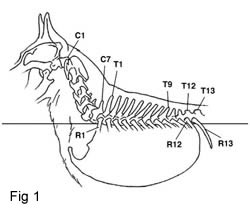 THE
NECK
THE
NECK
The seven cervical vertebrae (Fig 1, C1 to C7) of the neck
show a slight “S” curve, giving it an elegant, arched
appearance. This provides a sufficiently long neck when
stretched as well as the shorter, more massive muscling
required for strength, the prevention of injury, and the
wide base for attachment of the scapular muscles required to
draw the shoulder forward. An excessively long neck is more
vulnerable to injury in protection, while a short, stuffy
neck makes nosework awkward and tiring. Static head carriage
will be approximately at a right angle to a well laid back
shoulder, or a little higher when the dog is alerted.
Vertical carriage suggests a high, steep wither and topline,
probably due to a low, over-angulated rear. Low carriage may
be due to a roached back sloping down into a low, flattened
wither. Correct head carriage gives the dog an alert, noble
bearing and maximum flexibility in its work.
THE WITHERS
The withers are part of the spine proper, consisting of the
first nine (Fig 1, T1 to T9) of the thirteen thoracic
vertebrae and supporting the first nine true ribs (Fig 1, R1
to R9). The uppermost processes of these vertebrae are
greatly elongated and sloping backward, giving the withers a
sloping profile, forming the highest point of the dog’s
torso and anchoring the scapular muscles required to draw
the shoulder backward.
However, the disk portions of
the vertebrae are aligned horizontally in a dog standing
naturally foursquare, and only slightly sloped in a show
posed dog (Fig 2). Excessively high withers are generally
due, not to longer processes or a straight shoulder, but to
a steeply sloping spine, again resulting from an
over-angulated rear (Fig 3). Flat withers, which seem
undifferentiated in profile from the rest of the back, may
result from either a high set rear, or from a roaching of
the spine which angles the withers downwards toward the head
(Fig 4). In both cases, incorrectly oriented withers
compromise the ability of the scapula to rotate freely.
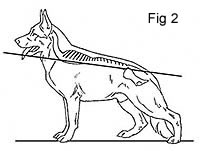
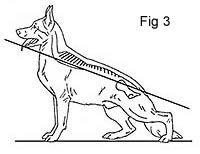
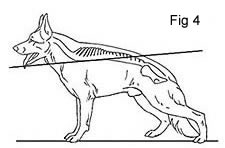
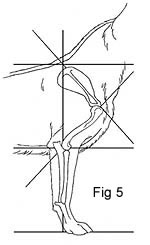 THE
SHOULDER
THE
SHOULDER
The shoulder assembly is formed by the scapula or shoulder
blade, articulated with the humerus or upper arm (Fig 5). It
is important to remember there is no skeletal attachment of
the shoulder to the body; it rides solely in a bed of
muscle. Hence a very loosely ligamented dog may tend to show
good reach even with an upright shoulder, while mature dogs
with good shoulders, especially males, may show less reach
than they displayed in their youth. Obviously, good
conditioning can help maintain good reach.
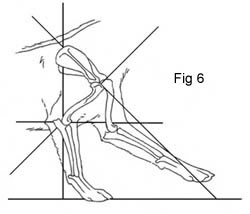 Angulation
of the shoulder is important for free reach, but it is not
true that the static angle of scapula to humerus must be 90
degrees. This is simply because, when the animal is in
motion, its center of gravity drops, the body is lowered
slightly and shoulder angulation at the supporting position
closes to achieve 90 degrees (Fig 6). As well, the shoulder
must carry the greater proportion of the dog’s weight, and
the more vertical the supports, the less energy is consumed
- try standing with your knees bent. Layback is necessary
for motion, but an upright position is necessary for
support. The best performing shoulder will be a compromise
between the two. A 95 degree angle is more than sufficient
to provide ample forward reach, impact absorption and
support. Extreme extension at the trot is not especially
desirable because this is an endurance gait, used to
conserve energy. Maximum extension and energy consumption
should be reserved for the gallop.
Angulation
of the shoulder is important for free reach, but it is not
true that the static angle of scapula to humerus must be 90
degrees. This is simply because, when the animal is in
motion, its center of gravity drops, the body is lowered
slightly and shoulder angulation at the supporting position
closes to achieve 90 degrees (Fig 6). As well, the shoulder
must carry the greater proportion of the dog’s weight, and
the more vertical the supports, the less energy is consumed
- try standing with your knees bent. Layback is necessary
for motion, but an upright position is necessary for
support. The best performing shoulder will be a compromise
between the two. A 95 degree angle is more than sufficient
to provide ample forward reach, impact absorption and
support. Extreme extension at the trot is not especially
desirable because this is an endurance gait, used to
conserve energy. Maximum extension and energy consumption
should be reserved for the gallop.
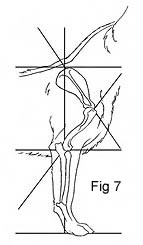 The
scapula is slightly shorter than the upper arm and is not,
unlike the scapula of the horse, capped with cartilage. Its
shortness, combined with its huge area of muscular
attachment, makes it an extremely powerful lever. Despite
the length differential, the greatest efficiency of movement
is achieved when the angle of the upper arm mirrors the
angle of the scapula. A great deal of comment is made by
judges on the slope of a dog’s upper arm, with no mention of
the corresponding angle of the scapula, but I have never
seen an animal with a short, upright upper arm who did not
also have an upright shoulder blade, generally resulting in
a shortened stride (Fig 7, Fig 8). The scapula can be very
difficult to see or feel in a strongly muscled dog, but it
normally mirrors the slope of the upper arm.
The
scapula is slightly shorter than the upper arm and is not,
unlike the scapula of the horse, capped with cartilage. Its
shortness, combined with its huge area of muscular
attachment, makes it an extremely powerful lever. Despite
the length differential, the greatest efficiency of movement
is achieved when the angle of the upper arm mirrors the
angle of the scapula. A great deal of comment is made by
judges on the slope of a dog’s upper arm, with no mention of
the corresponding angle of the scapula, but I have never
seen an animal with a short, upright upper arm who did not
also have an upright shoulder blade, generally resulting in
a shortened stride (Fig 7, Fig 8). The scapula can be very
difficult to see or feel in a strongly muscled dog, but it
normally mirrors the slope of the upper arm.
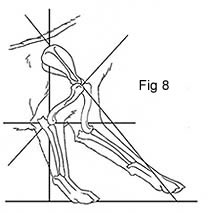 To
feel the shoulder, locate the groove on either side of the
breastbone of a dog standing foursquare. Immediately behind
this is the point-of-shoulder, the joint between the scapula
and humerus. The humerus slopes from this point to the elbow
joint. The upper tip of the scapula should be directly above
the elbow, at about the second or third thoracic vertebrae.
With the tips of the fingers, one can palpate the spina
scapulae, a sharp, deep ridge of bone that runs the length
of the center of the scapula, and separates the muscles that
draw the blade forwards and backwards. This spine closely
follows the slope of the scapula, not the front or rear
edges of the blade, which is actually quite broad. Many
beginners are surprised to find the scapula is often much
more upright than they predicted from simple observation,
perhaps assuming it follows the black “harness line” that
sometimes runs at a 45 degree angle across the coat of the
shoulder.
To
feel the shoulder, locate the groove on either side of the
breastbone of a dog standing foursquare. Immediately behind
this is the point-of-shoulder, the joint between the scapula
and humerus. The humerus slopes from this point to the elbow
joint. The upper tip of the scapula should be directly above
the elbow, at about the second or third thoracic vertebrae.
With the tips of the fingers, one can palpate the spina
scapulae, a sharp, deep ridge of bone that runs the length
of the center of the scapula, and separates the muscles that
draw the blade forwards and backwards. This spine closely
follows the slope of the scapula, not the front or rear
edges of the blade, which is actually quite broad. Many
beginners are surprised to find the scapula is often much
more upright than they predicted from simple observation,
perhaps assuming it follows the black “harness line” that
sometimes runs at a 45 degree angle across the coat of the
shoulder.
LOWER ARM, PASTERN AND FOOT
The lower arm, or radius/ulna combination, is equal in
length to the upper arm or perhaps a little longer, but
never shorter (Fig 9). It is long enough to give great speed
and jumping ability when necessary, and short enough to give
endurance and resistance to injury. The leg should be
absolutely straight, forward facing and perpendicular to the
ground (Fig 10), but it also has a limited ability to
rotate, increasing agility. A dog’s quality of bone and
muscular condition are immediately apparent in the lower
arm.
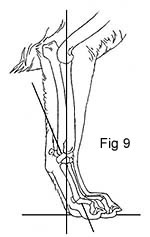
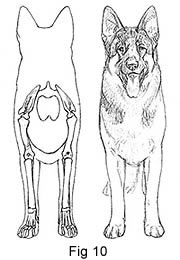 The
pastern, or metacarpals, serves primarily to absorb the
impact of the stride. In jumping, this impact can be
considerable. It is not true that a softer pastern increases
shock absorption. In fact, the softer the joint, the more
easily it compresses and the less absorption is available,
much like old shocks on a car. A straight pastern is capable
of absorbing the most energy, but a small amount of angle,
about 22 degrees, is desirable to ensure that the joint does
not knuckle over on impact. I have illustrated (Fig 11),
from left to right, a cat foot and upright pastern, a
correct foot, two stages of breakdown of the foot and
pastern, and a soft pastern in motion, showing the degree of
breakdown when stress is applied. Some dogs actually drive
their carpal (wrist) pads into the ground while merely
trotting.
The
pastern, or metacarpals, serves primarily to absorb the
impact of the stride. In jumping, this impact can be
considerable. It is not true that a softer pastern increases
shock absorption. In fact, the softer the joint, the more
easily it compresses and the less absorption is available,
much like old shocks on a car. A straight pastern is capable
of absorbing the most energy, but a small amount of angle,
about 22 degrees, is desirable to ensure that the joint does
not knuckle over on impact. I have illustrated (Fig 11),
from left to right, a cat foot and upright pastern, a
correct foot, two stages of breakdown of the foot and
pastern, and a soft pastern in motion, showing the degree of
breakdown when stress is applied. Some dogs actually drive
their carpal (wrist) pads into the ground while merely
trotting.
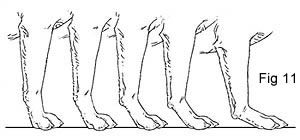
The pastern also generates
its own propulsive power with each stride. At maximum
compression, fully supporting the dog’s weight, the tendons
running down the back of the pastern and foot are stretched,
gathering energy. Short tendons stretch the most, and the
straighter pastern has the shorter tendons. As the foreleg
moves into the back-swing and follow-through, these tendons
snap like elastics, releasing energy and generating
propulsion. From the front, any tendency for the pasterns to
bend or twist will warp the direction of force, wasting
energy and making the leg vulnerable to injury (Fig 12).

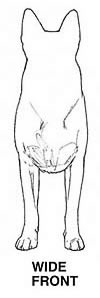

 The
forefoot carries a greater proportion of the dog’s weight
than does the hind foot, and is somewhat larger. Each toe is
angled at nearly 90 degrees, elevating the foot over very
thick, absorptive pads. The toes are held closely together,
to better absorb energy and prevent injury. However, the
foot is not catlike, but slightly elongated to give
increased leverage, stride and speed, and the ability to
spread widely in snow or water. The toes are webbed, as much
as any retriever. When standing the feet should point
straight ahead or only very slightly outwards. A working dog
can function reasonably well with minor deviations of almost
any part of its structure, but weak feet and pasterns will
not withstand heavy stress over the long term, especially
that tolerated by guides dogs and police dogs who must work
long hours on asphalt and concrete. After temperament, sound
feet are perhaps a working dog’s most essential tool.
The
forefoot carries a greater proportion of the dog’s weight
than does the hind foot, and is somewhat larger. Each toe is
angled at nearly 90 degrees, elevating the foot over very
thick, absorptive pads. The toes are held closely together,
to better absorb energy and prevent injury. However, the
foot is not catlike, but slightly elongated to give
increased leverage, stride and speed, and the ability to
spread widely in snow or water. The toes are webbed, as much
as any retriever. When standing the feet should point
straight ahead or only very slightly outwards. A working dog
can function reasonably well with minor deviations of almost
any part of its structure, but weak feet and pasterns will
not withstand heavy stress over the long term, especially
that tolerated by guides dogs and police dogs who must work
long hours on asphalt and concrete. After temperament, sound
feet are perhaps a working dog’s most essential tool.